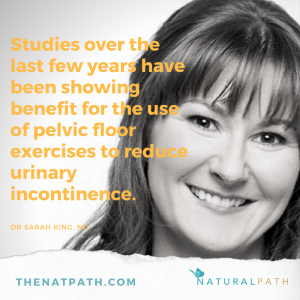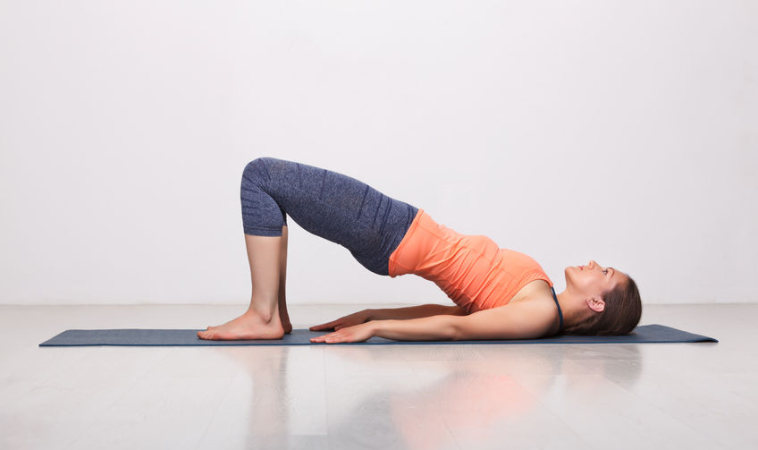The Structure of the Pelvic Floor Serves as Support for the Pelvic Organs
 These muscles include the pelvic diaphragm and the levator ani complex which forms a sling around the urethra, distal vagina, and rectum. Without this structural support, women, especially, are at risk of developing pelvic floor disorders such as pelvic organ prolapse, overactive bladder syndrome, stress urinary incontinence, and fecal incontinence. Damage or weakening of these muscles can occur as a result of childbirth, aging, repetitive bouncing or jumping, and previous “non-use” or non-strengthening of the pelvic floor muscles. Specialized physiotherapy for the pelvic muscles may be able to provide muscle training and strengthening to reduce prolapse, and other common bladder symptoms that women experience.
These muscles include the pelvic diaphragm and the levator ani complex which forms a sling around the urethra, distal vagina, and rectum. Without this structural support, women, especially, are at risk of developing pelvic floor disorders such as pelvic organ prolapse, overactive bladder syndrome, stress urinary incontinence, and fecal incontinence. Damage or weakening of these muscles can occur as a result of childbirth, aging, repetitive bouncing or jumping, and previous “non-use” or non-strengthening of the pelvic floor muscles. Specialized physiotherapy for the pelvic muscles may be able to provide muscle training and strengthening to reduce prolapse, and other common bladder symptoms that women experience.
In general, pelvic floor disorders are most common in adult women, occurring in about 24% of women in the USA.1Apart from aging, other risk factors include obesity, and having given birth vaginally, with a greater risk for multiple childbirths.1Urinary incontinence is very common immediately postpartum, and is more likely to occur in women who had prolonged labor, or a longer second stage of labor.1Additionally, the use of physical interventions during labor, such as forceps, vacuum, and episiotomy, also increase the risk.1One study showed that women who underwent instrument-assisted births had an eight-fold increase in pelvic organ prolapse at 5 to 10 years postpartum.1
Urinary Incontinence
Stress urinary incontinence occurs as a result of movement, or physical pressure, on the bladder, and leads to unintentional loss of urine. Although common, symptoms of urinary incontinence can interfere in a woman’s daily work and activities, and can even deter women from wanting to exercise.
One study reported that 11% of women with urinary incontinence do not exercise because of their symptoms, while an additional 11% said they exercised less than they normally would have due to symptoms.2
Severe bladder leakage can lead to major negative impacts on daily living. Areas affected include concentration, self-confidence, performance of physical activities at work, and the ability to complete tasks without interruption, or without feeling distracted.2
The risk of developing urinary incontinence seems to increase with delayed childbearing. A British study found an association between women who were a maternal age of 30 or older for their first vaginal delivery, and the incidence of urinary incontinence.1 As well, pushing longer than an hour during the second stage of labor has been associated with denervation injuries to the pelvis. This may cause soft tissue and neuromuscular damage, as opposed to women who have a passive second stage of labor where the risk of this type of damage is significantly reduced.1
Studies over the last few years have been showing benefit for the use of pelvic floor exercises to reduce urinary incontinence. Current recommendations state that pelvic floor physiotherapy should not be attempted before 2-3 months postpartum.3 A minimum of 3 guided sessions are recommended with women continuing their exercises at home; however, a common methodology among studies has been the inclusion of 5 sessions of one-on-one individualized instruction before allowing subjects to continue on their own.3 Treatments were continued throughout a span of 16 weeks which correlates with the approximate time necessary to gain muscle mass in these muscle groups.4
Pelvic Organ Prolapse
Prolapse of pelvic organs describes the descent of the anterior or posterior vaginal wall, the uterus, or the vaginal vault from their normal anatomical position.5 A mild prolapse often incurs symptoms of pelvic pressure or heaviness, pelvic pain, and urinary and/or bowel symptoms.6 Although surgical correction can be used for severe prolapse, it is not always recommended.
For mild prolapse, watchful waiting is often recommended and typically includes providing women with literature on the importance of maintaining a healthy weight, avoiding heavy lifting, and treating constipation.
Pelvic Floor Muscle Training
Muscle training for the pelvic floor is designed to increase the strength, endurance, and coordination of these muscles and ultimately increase the structural support for the pelvic organs.4 With individualized instruction, women can learn to contract their pelvic floor muscles to build up muscle tone so that pelvic organs are better held in place.6 Additionally, practicing this technique consciously, before and during any increase in intra-abdominal pressure, can reduce symptoms such as stress incontinence or prolapse from coughing.5
Studies have shown that practicing pelvic floor exercises can help improve symptoms of urinary incontinence. One study in women 55 years and older showed significant improvements in pelvic floor distress symptoms with pelvic floor physiotherapy, compared to watchful waiting.6 Interestingly, this study also reported that women who received physiotherapy treatment seemed to gain more insight into their symptoms and condition, leading to a higher subjective appreciation of improvement.6
Though pelvic floor muscle training has also been shown to reduce symptoms of prolapse, the length of benefit isn’t conclusive. One study showed that training, which included 5 personalized sessions, lead to a significantly greater reduction in prolapse symptoms at 12 months, as well as 6 months and 1-year post-treatment.4 However, another study showed improvement in symptoms for up to 12-months post training treatment, but not in the long-term, at 6-12 years.3 This could be due to aging as the risk of pelvic floor disorders increases with age, or due to a lack of continued and regular practice of exercises.
Although some risk factors for pelvic floor disorders are unavoidable, such as aging and previous vaginal child birth, pelvic floor exercises may provide a beneficial treatment solution for the reduction of urinary and prolapse symptoms. Watchful waiting alone can be frustrating for many women and can cause unnecessary distractions and interruptions from day-to-day. Individualized and guided sessions with a trained professional, as opposed to written instruction, can help ensure that exercises are done properly. Having a supervised session also provides a way to properly monitor progress.
References
- Memon, H.U., and Handa, V.L. (2013). Vaginal childbirth and pelvic floor disorders. Womens Health (Lond). 9(3):265-77
- Nygaard, I.E., and Shaw, J.M. (2016) Physical activity and the pelvic floor. Am J Obstet Gynecol. 214(2): 164-171
- Deffieux, X., Vieillefosse, S., Billecocq, S., et al. (2015) [Postpartum pelvic floor muscle training and abdominal rehabilitation: Guidelines] J Gynecol Obstet Biol Reprod (Paris). 44(10):1141-6
- Hagan, S., Stark, D., Glazener, C., et al. (2014). Individualized pelvic floor muscle training in women with pelvic organ prolapse (POPPY): a multicentre randomized controlled trial. Lancet. 383(9919): 796-806
- McClurg, D., Hilton, P, Dolan, L., et al. (2014) Pelvic floor muscle training as an adjunct to prolapse surgery: a randomized feasibility study. Int Urogynecol J.25(7):883-91
- Wiegersma, M., Panman, C.M., Kollen, B.J., et al. (2014) Effect of pelvic floor muscle training compared with watchful waiting in older women with symptomatic mild pelvic organ prolapse: randomized controlled trial in primary care. BMJ.239:g7378
Image Copyright: <a href=’https://www.123rf.com/profile_dimol’>dimol / 123RF Stock Photo</a>
 Dr. Sarah King is a licensed Naturopathic Doctor, graduating from the Canadian College of Naturopathic Medicine in 2014. Prior to completing her medical studies, she attended Nipissing University where she received her Honors Bachelor of Science in Biology. Sarah has a passion for women’s health and is a birth doula in Durham and Toronto Region. She treats a wide variety of health conditions including menstrual disorders and hormone balancing, fertility, prenatal care, digestive concerns, skincare and mental health/anxiety. Outside the office Sarah is an avid runner with a love of the GTA’s best forest trails. She also continues to improve her yoga practice and teaches breath work as part of stress management counselling to her patients.
Dr. Sarah King is a licensed Naturopathic Doctor, graduating from the Canadian College of Naturopathic Medicine in 2014. Prior to completing her medical studies, she attended Nipissing University where she received her Honors Bachelor of Science in Biology. Sarah has a passion for women’s health and is a birth doula in Durham and Toronto Region. She treats a wide variety of health conditions including menstrual disorders and hormone balancing, fertility, prenatal care, digestive concerns, skincare and mental health/anxiety. Outside the office Sarah is an avid runner with a love of the GTA’s best forest trails. She also continues to improve her yoga practice and teaches breath work as part of stress management counselling to her patients.
















